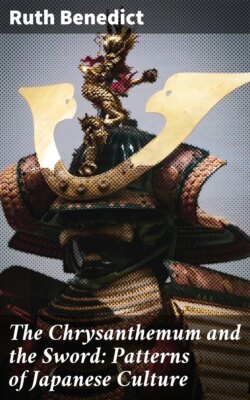The Chrysanthemum and the Sword: Patterns of Japanese Culture

Реклама. ООО «ЛитРес», ИНН: 7719571260.
Оглавление
Ruth Benedict. The Chrysanthemum and the Sword: Patterns of Japanese Culture
The Chrysanthemum and the Sword: Patterns of Japanese Culture
Table of Contents
1
Assignment: Japan
2
The Japanese in the War
3
Taking One’s Proper Station
4
The Meiji Reform
5
Debtor to the Ages and the World
6
Repaying One-Ten-Thousandth
7
The Repayment ‘Hardest to Bear’
8
Clearing One’s Name
9
The Circle of Human Feelings
10
The Dilemma of Virtue
11
Self-Discipline
12
The Child Learns
13
The Japanese Since VJ-Day
Glossary
Index
Отрывок из книги
Ruth Benedict
Published by Good Press, 2021
.....
The student who is trying to uncover the assumptions upon which Japan builds its way of life has a far harder task than statistical validation. The great demand upon him is to report how these accepted practices and judgments become the lenses through which the Japanese see existence. He has to state the way in which their assumptions affect the focus and perspective in which they view life. He has to try to make this intelligible to Americans who see existence in very different focus. In this task of analysis the court of authority is not necessarily Tanaka San, the Japanese ‘anybody.’ For Tanaka San does not make his assumptions explicit, and interpretations written for Americans will undoubtedly seem to him unduly labored.
American studies of societies have not often been planned to study the premises on which civilized cultures are built. Most studies assume that these premises are self-evident. Sociologists and psychologists are preoccupied with the ‘scatter’ of opinion and behavior, and the stock technique is statistical. They subject to statistical analysis masses of census material, great numbers of answers to questionnaires or to interviewers’ questions, psychological measurements and the like, and attempt to derive the independence or interdependence of certain factors. In the field of public opinion, the valuable technique of polling the country by using a scientifically selected sample of the population has been highly perfected in the United States. It is possible to discover how many people support or oppose a certain candidate for public office or a certain policy. Supporters and opponents can be classified as rural or urban, low income or high income, Republicans or Democrats. In a country with universal suffrage, where laws are actually drafted and enacted by the people’s representatives, such findings have practical importance.
.....